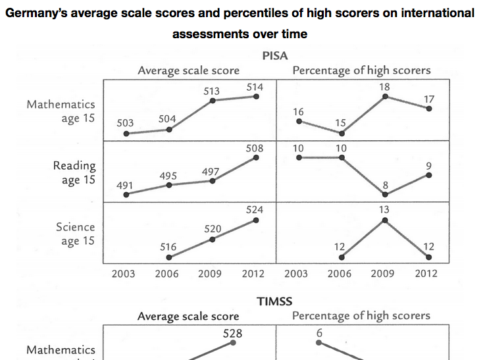New York is leaving too many gifted children behind. Scads of K–3 students in low-income neighborhoods aren’t even taking entrance exams for gifted programs. Four of the city’s 32 school districts don’t even have programs for gifted students, and many that do aren’t getting the word out. Which leaves it to savvy, pushy parents and watchful teachers to nudge kids forward, an arrangement that nearly always works better in middle-class communities.
Officials promised to continue trying to boost these numbers — but that’s not all that ails New York City’s approach to high-ability learners.
Every January, K–3 students who sign up for it may take a test to get into one of the city’s generally oversubscribed gifted programs. There’s a single city-wide score used to separate the wheat from the chaff: Pass, and you’re in; fail, and you’re not.
On its face, that approach looks fair. But it’s not. In Bedford-Stuyvesant’s District 16, for example, just 15 percent of test takers passed last year. In South Bronx District 7, it was 5 percent. Yet across a couple of rivers in Manhattan’s District 2, spanning the Upper East Side and much of the West Side, a whopping 42 percent of students who took the test qualified for gifted programs.
That’s not because prosperous neighborhoods are awash in smart kids. But ability-testing children ages 5 to 8 is most apt to reveal the effects of home and socioeconomic status, as well as hinting at innate ability.
As we argue in our new book, “Failing Our Brightest Kids: The Global Challenge of Educating High-Ability Students,” there are better ways to identify and place high-ability children. Start by giving everyone a fair shot. Take advantage of universal screening. Instead of using a separate, optional test for gifted programs, use one that everybody takes, such as the state achievement tests that kick in by third grade.
Use those results to identify the top 5 percent or so of test takers in each school or district, not the top 5 percent in the entire city. This will diversify the qualifying population and not just favor upper-middle-class kids.
Universal screening, according to economists Laura Giuliano and David Card, works especially well for minority students. And looking for top performers in every school is why Texas offers university admission to the top 10 percent of graduates from every high school rather than the top 10 percent statewide.
Next, ask all elementary teachers to nominate another 5 percent who may not be top scorers but who show uncommon potential. Encourage them to look at everything, not just at grades and scores.
If New York City combined these two steps, it would identify about 10 percent of students who are already high achievers or, in their teachers’ eyes, could be. This is a generous-enough definition of the gifted population to mitigate charges of elitism and dampen the competition to participate that is apt to work against those without educated or driven parents.
Yes, it will also upset a lot of middle-class families. Yes, the city also needs more “gifted and talented” opportunities of various kinds than it’s currently supplying, and it needs them all over town. Yes, there should be supplemental, after-school and summer options, too — things that philanthropy can help expand.
Why do today’s “gifted and talented” programs often get tarred with the brush of “elitism”? Because the way we organize the K-12 system gives undue advantage to those who already have some advantages.
Because federal and state laws also ignore them, high-ability poor kids are among the most neglected populations in American public education. Yet they, too, deserve an education that meets their needs and enhances their futures, just like children with other distinctions and problems.
They have their own legitimate claim on our conscience, our sense of fairness, our policy priorities and our education budgets. Those kids depend more than upper-middle-class youngsters on the public-education system. Some will manage to overcome the constraints of their origins but many will fall by the wayside, destined by circumstances beyond their control never to realize their full potential.
New York City ought to be doing all it can to push these able, disadvantaged youngsters up the ladder. But today’s practices are keeping them down.
– Brandon L. Wright and Chester E. Finn, Jr.
This appeared earlier on Flypaper. A slightly different version of this article originally appeared in the New York Post





